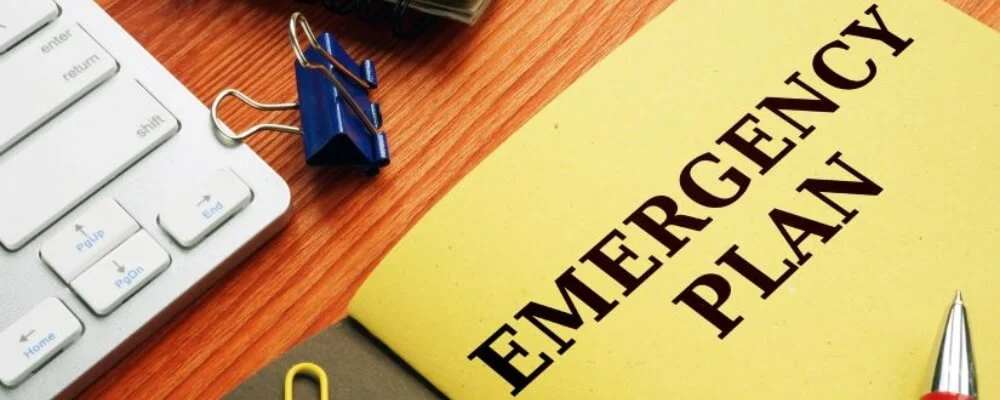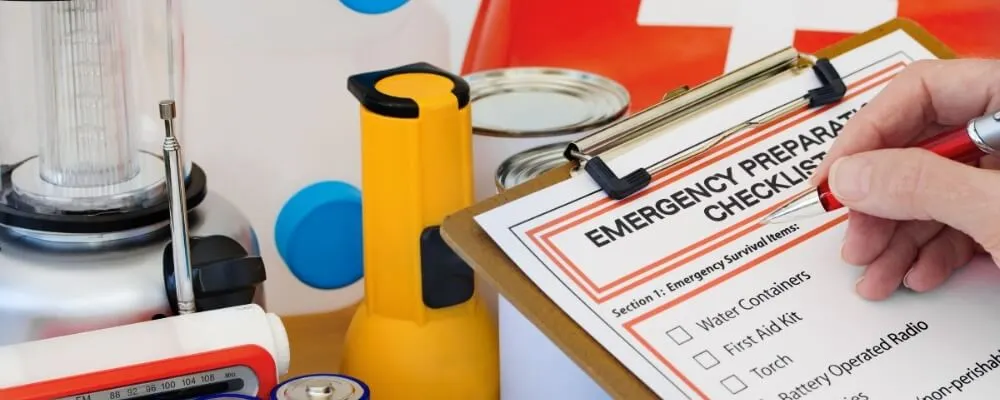In today’s unpredictable world, where natural and man-made disasters can strike without warning, being prepared is more crucial than ever. An Emergency Management Plan (EMP) serves as a blueprint, guiding organizations and communities through the chaos and uncertainty of unexpected events. But what makes an EMP effective? It’s not just about having a plan on paper but ensuring it’s comprehensive, actionable, and adaptable.
In this blog, we’ll explore the 10 key components that form the backbone of a robust Emergency Management Plan, ensuring you’re not just prepared but poised to respond and recover with efficiency and resilience.
What’s an Emergency Management Plan?
An Emergency Management Plan (EMP) is a document that outlines the processes and procedures to be followed before, during, and after an emergency or disaster to ensure the safety and well-being of an organization’s employees, facilities, and stakeholders. The goal of the plan is to minimize the impact of disasters and to facilitate recovery efforts.
An Emergency Management Plan (EMP) plays a pivotal role in ensuring an organization or community’s safety, continuity, and resilience in the face of potential disasters. Here’s an exploration of the importance of an Emergency Management Plan:
- Safety and Protection: An EMP’s primary aim is to protect human life. The plan ensures that employees and the general public can stay safe during a crisis by detailing evacuation routes, communication protocols, and first-aid procedures.
- Minimizing Operational Disruption: Disasters can halt operations, leading to financial losses and reduced service delivery. An EMP provides the framework to quickly adapt and continue operations, ensuring minimal downtime and maintaining essential services.
- Resource Allocation: Knowing what resources are required during an emergency – from manpower to equipment – allows organizations to efficiently allocate and utilize resources when needed.
- Legal and Regulatory Compliance: Many jurisdictions and industries have laws and regulations requiring entities to have emergency or disaster preparedness plans. An EMP ensures compliance with these mandates, potentially avoiding legal consequences and liabilities.
- Reputation Management: In the digital age, where news travels fast, how an organization handles crises can significantly impact its reputation. A well-executed EMP can help maintain public trust and stakeholder confidence by demonstrating preparedness and effective response capabilities.
- Financial Savings: While developing an EMP requires an initial investment, it can result in significant cost savings in the long run. Preparedness can reduce the extent of property damage, lessen business interruptions, and decrease potential liability issues.
- Psychological Assurance: Knowing a plan in place provides peace of mind to employees, stakeholders, and the community. It fosters a sense of security and understanding that proactive measures have been taken to address potential threats.
- Continuous Improvement: Regular drills and post-incident reviews contribute to continuous improvement as part of the EMP. They help identify gaps and refine the plan, ensuring it remains effective and relevant.
- Strengthening Community and Organizational Resilience: Communities or organizations with robust EMPs tend to recover faster post-disaster. They can adapt, reorganize, and grow despite facing adversities, making them more resilient in the long run.
- Facilitating Coordination and Communication: Coordinated efforts are essential in emergencies to prevent chaos. EMPs provide a clear command structure, roles, and communication strategies, ensuring everyone knows their responsibilities and how to collaborate effectively.
While the hope is that emergencies and disasters can be entirely avoided, reality dictates a need for preparedness. An Emergency Management Plan equips organizations and communities with the tools, knowledge, and strategies they need to face such events head-on, mitigate their effects, and emerge stronger on the other side.

10 Key Components Of An Emergency Management Plan
An emergency management plan is a comprehensive framework designed to guide an organization, community, or entity in effectively responding to, mitigating, and recovering from various types of emergencies and disasters. Here are 10 key components that are typically included in an emergency management plan:
1. Purpose and Scope
An Emergency Management Plan’s “Purpose and Scope” section sets the stage for the plan’s existence and its overarching goals. It clarifies what the plan aims to achieve, such as ensuring the safety of all personnel, minimizing operational disruptions, or protecting physical assets. This section also highlights the types of emergencies or hazards the plan is designed to address, ranging from natural disasters like hurricanes and floods to human-made events like chemical spills or cyberattacks.
Additionally, it delineates the boundaries of the plan’s application, indicating whether it applies only to specific sites, regions, or the entire organization. This ensures no ambiguity about when and where the plan should be implemented.
2. Roles and Responsibilities
Knowing one’s role is crucial in any emergency to ensure a coordinated and efficient response. The “Roles and Responsibilities” segment delineates different individuals’ or teams’ duties and expected actions when a disaster strikes. For example, while the primary responsibility of a first response team might be to evacuate people from a hazard zone, the management could be tasked with decision-making and resource allocation.
By defining these roles clearly, the plan ensures no overlap or confusion during the critical moments of a crisis, leading to a smoother and more effective response.
3. Risk Assessment
This foundational analysis informs the rest of the plan. A thorough “Risk Assessment” identifies potential threats to the organization. These could include natural calamities, technological failures, security breaches, and more. After identifying these threats, the assessment gauges the likelihood of each event occurring and its potential impact on the organization’s operations, reputation, and finances.
Such an analysis helps prioritize which risks need immediate attention and resources, ensuring the organization is better prepared for the most pressing threats.
4. Emergency Response Procedures
The crux of the plan lies in the “Emergency Response Procedures” section. Here, detailed, actionable steps are laid out for different emergencies. For instance, in the event of a fire, this section would specify evacuation routes, meeting points, and how to use fire safety equipment.
The procedure might involve immediate shelter-in-place orders if the risk is a chemical spill. What’s essential is that these procedures are clear and concise, making them easy to follow during high-stress situations.
5. Communication Plan
Effective communication is the lifeline of any crisis response. The “Communication Plan” ensures accurate and timely information flows seamlessly among all stakeholders within and outside the organization. Internally, this could involve alerting employees about the nature of the emergency and guiding them on the next steps.
The organization might need to communicate with local authorities, media, or affected communities. This section also defines the tools and channels for communication, such as emergency alert systems, emails, or public address systems. The communication must be clear, consistent, and controlled to prevent panic and misinformation.

6. Training and Exercise
Ensuring individuals are well-equipped to handle emergencies goes beyond creating a plan—it demands regular training and practice. The “Training and Exercise” section focuses on developing and maintaining a competent response from everyone involved. This involves detailing the frequency, content, and method of training sessions. For instance, employees might be trained annually on general emergency preparedness, while specialized teams undergo quarterly sessions on specific procedures.
Beyond training, this section also emphasizes the importance of drills or exercises that simulate real-life emergencies. These exercises, be they fire drills or mock cyber-attack responses, test the plan’s practical application, offering invaluable insights into its strengths and areas for improvement.
7. Resource Management
In an emergency, having immediate access to the right resources can make a significant difference. Resource Management focuses on identifying and cataloging crucial equipment, supplies, and personnel integral to the plan’s execution. These could range from first aid kits and emergency generators to specialized response teams and communication tools.
However, merely listing them isn’t enough. This section also details logistics, highlighting how these resources would be procured, where they would be stored, and the regular maintenance and check protocols. Effective resource management ensures the organization isn’t lacking when disaster strikes.
8. Recovery and Restoration
Emergencies inevitably lead to disruptions, but the goal is always to return to normalcy as quickly and efficiently as possible. The “Recovery and Restoration” segment is dedicated to transitioning from chaos to routine. This involves steps to assess the immediate aftermath of the crisis, from property damage to data loss, and strategies to address them. Here, business continuity plans come into play, detailing how essential services and functions can be resumed or rerouted.
Furthermore, considering the long-term impact of the disaster, strategies might be outlined to handle repercussions, be it rebuilding infrastructure, addressing reputational damage, or supporting affected employees and stakeholders.
9. Plan Maintenance and Review
Like any strategic document, an Emergency Management Plan is not meant to gather dust on a shelf. The “Plan Maintenance and Review” section underscores the dynamic nature of the plan. It specifies the regularity with which the plan should be revisited—annually or after every drill or emergency. This regular review ensures the plan remains relevant, accounting for organizational structure, technology, or risk environment changes.
This section also identifies who is responsible for this review, whether a dedicated emergency management team, a department, or an external agency. This ensures ownership and accountability in keeping the plan up-to-date.
10. Annexes
While the main body of the Emergency Management Plan offers a broad overview, “Annexes” serve as deep dives into specific topics. These can be considered supplementary material that provides granular details without overwhelming the main document.
Depending on the organization’s needs, these could include specialized response strategies for particular hazards, detailed floor plans highlighting evacuation routes, or in-depth protocols for specific scenarios, like handling hazardous materials. Housing this information in annexes makes the plan accessible and readable while offering comprehensive resources for those needing it.

Implementing an Emergency Management Plan Effectively
Implementing an Emergency Management Plan (EMP) effectively requires a systematic approach, commitment from leadership, and active participation from all stakeholders. Here’s a step-by-step guide on how to effectively implement an EMP:
- Gain Leadership Support: Implementation starts at the top. Secure buy-in from senior management or community leaders. Their support ensures the allocation of necessary resources and underscores the plan’s importance to all involved.
- Appoint a Dedicated Team: Designate a team or individual responsible for coordinating the EMP. Depending on the organization’s size and complexity, this can be an emergency management committee or a designated officer.
- Communicate the Plan: Share the EMP with all stakeholders, including employees, volunteers, community members, and even suppliers or partners. Ensure they understand the plan’s importance, their roles, and responsibilities.
- Training and Education: Organize training sessions for everyone involved. This can range from general awareness training for all employees to specialized training for emergency response teams.
- Conduct Drills and Simulations: Regularly test the plan under simulated conditions. These can be tabletop exercises for decision-makers or full-scale mock drills. Real-time simulations help identify gaps and provide hands-on experience.
- Gather Feedback: After training sessions and drills, solicit feedback from participants. They might have insights into the plan’s unclear or impractical aspects.
- Update and Revise: Update the plan based on feedback and any observed inefficiencies during drills. An EMP should be a living document that evolves based on new risks, organizational structure changes, or exercise feedback.
- Integrate with External Agencies: Often, emergencies require collaboration with external agencies like fire departments, police, or relief agencies. Ensure they know your plan and discuss how you’ll collaborate in an emergency.
- Maintain Resources and Supplies: Regularly inspect and replenish emergency supplies and equipment, including first aid kits, communication devices, backup power sources, and other vital resources.
- Raise Awareness: Periodically remind everyone of the EMP’s existence, importance, and any changes made. Use newsletters, meetings, or dedicated awareness campaigns.
- Evaluate and Learn from Real Events: If an emergency occurs, conduct a post-event review. Analyze what worked, what didn’t, and where improvements can be made.
- Review Regularly: Even if no emergency occurs and no gaps are identified during drills, the EMP should be reviewed regularly. Changes in technology, infrastructure, personnel, or the external environment might necessitate updates.
- Document Everything: From training sessions and drill outcomes to post-event analyses, document everything. This provides a valuable reference and serves as evidence of due diligence in case of legal or regulatory scrutiny.
- Promote a Culture of Preparedness: Beyond just the formal plan, encourage a culture where everyone is mindful of risks and the importance of preparedness. This proactive mindset can be invaluable during unexpected situations.
In summary, effectively implementing an Emergency Management Plan is an ongoing process that demands regular attention, updates, and stakeholder engagement. It’s not just about having a plan on paper but ensuring everyone is ready and equipped to act when needed.
Conclusion
A well-structured Emergency Management Plan is not just a contingency; it’s a vital tool that underscores an organization’s or community’s commitment to safety, preparedness, and resilience. By understanding and integrating the 10 key components we’ve discussed, entities can confidently and clearly navigate the tumultuous waters of unforeseen crises.
Remember, it is not the absence of emergencies that determines our strength, but our preparedness and response to them. With a comprehensive EMP, we shield ourselves from potential disruptions and pave the way for a faster recovery and a stronger tomorrow.

